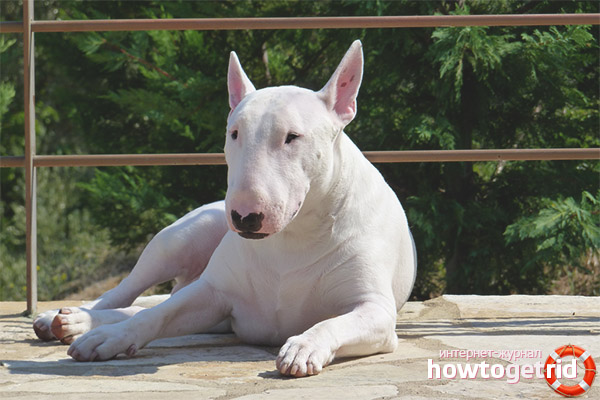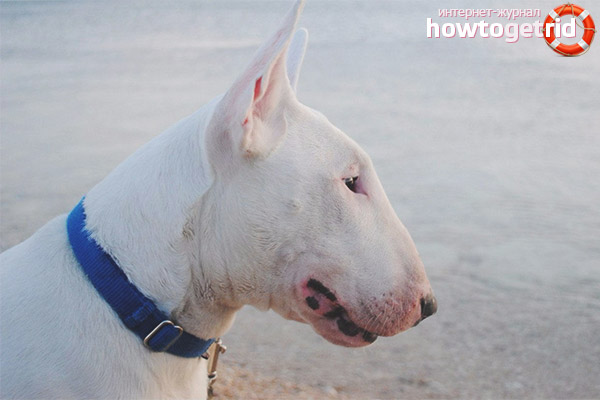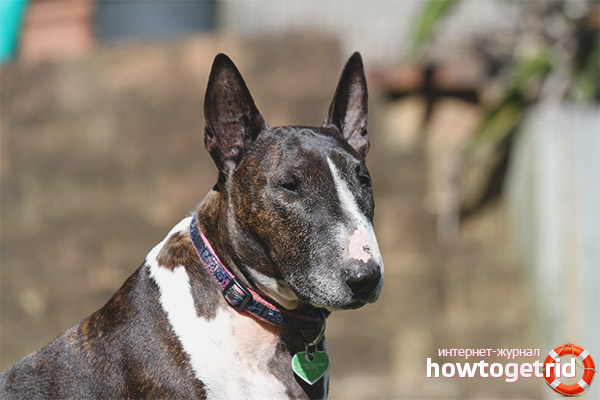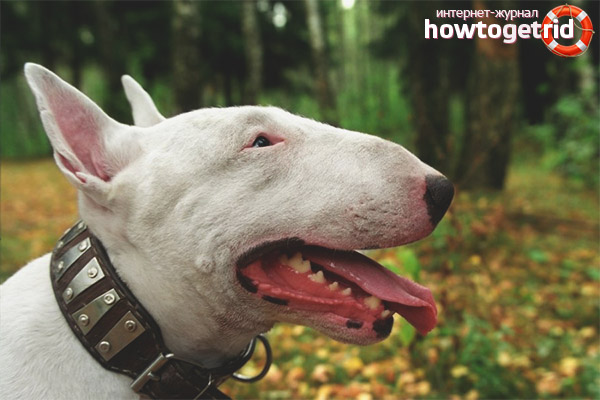The content of the article
In ancient times, such hobbies, which were characterized by cruelty, were popular. Many dog breeds were bred in order to participate in hunting and corrode large game, and not to keep the house. In particular, dogs were used as participants in fights between dogs. For a number of people, this was a method of earning - they put money on one of the animals, while others, usually wealthy people, wanted to attend a spectacular event in order to bring diversity into their quiet lives. The child of those harsh times is the bull terrier. The progenitors of these dogs were excellent fighters, but because of the people who were involved in their breeding, the breed acquired a more elegant look. Therefore, after the prohibition of fierce and bloody battles, the bull terriers were able to find a new path due to the peculiar appearance.
Name
Along with many terriers, "bulls" were bred in the UK. Therefore, the breed name refers to the English language. “Bull” in translation means “bull” - it was with these large animals that the bulldogs who took part in the formation of the breed entered the battle in the ring. And the word "terrier" refers to the second breed of dogs that participated in breeding processes.
History
While animal fighting in England was not banned, which happened in 1835, the participation of dogs in bull bullying was especially popular. The ancestors of the British Bulldogs participated in these battles. At that time, the appearance of these dogs was different: the limbs were high, and the head was square in shape and excessively wide. These features provided the dog with the opportunity to nimbly fight massive bulls. But after the ban, the organizers of fierce fighting found other methods of earning money - etching rats and fighting between dogs. Due to the smaller size of the participants, the arena could be created in any eatery, where both poor and wealthy people lived.
Soon it became clear that the military bulldog is practically not suitable for the newly minted format. In such battles it was necessary to have even greater intelligence and dexterity. Unfortunately, strong bulldogs failed to show their worth in such battles - they turned into a boring action.
Therefore, the breeders began to cross the bulldogs involved in the battles with other varieties of dogs. Particularly promising was selection with terriers. The breed bred possessed the same strength and stubbornness, while the dogs became more agile and intelligent. The name of the first representatives of the breed was unpretentious: "old-bull-and-terrier." So the ancestors of the current bull terriers were born.
Opportunity to survive
James Hinks, a dog lover and merchant, took care of this. He decided to make the breed look more beautiful, without changing the ability of dogs to fight. And a few years later, at an exhibition in Birmingim, the merchant presented the best result. Hinks realized that it was necessary to work on nobility in appearance, so the new representatives of the individual were completely white.And just then the modern name of the breed appeared - bull terrier.
The first individuals have already incorporated a number of qualities from their ancestors, including endurance, a developed mind, agility and energy. In Britain, the bull terrier instantly began to enjoy the love and respect of the dog breeder community. Owning a white bull terrier came into fashion, and with the beginning of the 20th century, breeders showed the world a colored breed of these dogs.
Color of bull terriers
In the second half of the nineteenth century, two Hinx pets nicknamed Madmen and Puss received championship titles. Despite the obvious differences from modern representatives of the breed, white bull terriers in those days were already in high demand. Due to interest from travelers and the military, the breed came to various countries.
Nevertheless, a number of serious problems remained, the solution of which required considerable efforts from the breeders. At first, the British government banned stopping ears of bull terriers, and this almost destroyed the increased popularity of dogs. The ears, being uncircumcised, looked terrible at these dogs. But due to the long work of breeders, specimens soon appeared whose ears were naturally erect.
But the main difficulty was that the bull terriers with colored wool were born discriminated against. Many people were of the opinion that they lack external nobility. And from the moment that colored dogs began to win at English exhibitions, many breeders protested the judges' decisions. In their opinion, obtaining colored dogs titles (which leads to the participation of these dogs in breeding) will lead to the fact that white bull terriers undergo degeneration. Therefore, not only multi-colored individuals, but also white, having colored dogs among their ancestors, lost their participation in mating. And such a decision almost turned into a disappearance of the breed. Due to the prolonged selection of white representatives of the breed, the gene pool of bull terriers has become more scarce. In addition, dogs acquired from their predecessors - white British terriers - a set of vices: from deafness to blue eyes and infertility.
By the mid-twentieth century, there were more puppies with disease. And just in order to avoid degeneration of the breed, colored individuals were allowed to participate in breeding. Experts promptly recalled that several years ago the champion title was obtained by a white bull terrier, whose ancestors were multi-colored individuals.
Victory
It is noteworthy that initially those who started the first dogs after selecting a bulldog with a terrier were indulgent towards the white Hinx bull terriers, considering them unsuitable for fighting. Breeders confidently stated that a beautiful dog is unlikely to be a great fighter. Then Hinks became a participant in the bet, the result of which forever changed the history of bull terriers. He bred his dog, nicknamed Puss - a forty-pound white bull terrier - against a more familiar and older dog at 60 pounds. For some thirty minutes, Puss mercilessly dealt with her, and James, who won the argument, won five pounds and a box of fine champagne. And the favorite of Hinx Puss, who practically did not suffer in the fight, a day later received the champion title at the show exhibition.
Breed standard
It is rather unusual that the bull terrier breed standard is not very clear. The weight range is from 17 to 32 kg, and growth can be from 31 to 46 cm. A number of restrictions on growth are present only in miniature representatives of the breed. Usually his height is less than 36 cm. When the dog's weight is within 19-31 kg, it is important to pay attention to the fact that the dog does not look too full or, conversely, skinny.
The main aspect of the standard is a strong build and well-developed musculature.The head has a low landing, massive, elongated, egg-shaped. It does not have distortions or irregularities. A scissor bite, the lower jaw has tremendous power. The nostrils are clearly visible, open.
Eyes are pigmented in brown, small and triangular. Ears are upturned, located close to each other. The limbs are strong and muscular, help the bull terrier to stand firmly on his feet. The body is roundish. The chest has strong muscles, not narrow. The tail is small, narrower at the end.
If the representative of the breed is white, then spots of a different color are allowed only on the head or ears. If it is color, then white should be inferior in scope to others.
Character Features
Bull terriers are traditionally considered fighting dogs. They have an extremely high pain threshold, they have increased strength and agility. But, as is the case with other dog breeds, it is upbringing that plays a key role in the character of the dog. When the owner and his pet are really friendly, and the dog from puppyhood understands everything. She knows that the owner is the most important, that he is a leader, and that it is necessary to obey him without resistance - in this case the bull terrier will become a true loyal friend.
Representatives of this breed have an active, restless and silly disposition. Before you start a bull terrier, you need to think about whether you are ready to spend several hours every day walking with your pet. Therefore, this dog is better suited to owners active, cheerful and young than old people.
Initially, the breed of these dogs was not bred in order to engage in battles with humans, despite the fact that it is fighting. According to the standard, among puppies born, it is necessary to leave only calm, balanced and reasonable individuals.
Aggressiveness and anger in the character of a dog can manifest itself if the processes of upbringing, training, and keeping in the family were not performed correctly. Bull terriers are capricious and jealous. It is unlikely that these dogs will put up with slave content or the need for reckless submission to the owner. This should be considered if you plan to have a bull terrier puppy. The owner will need a lot of love, respect, patience and care in order to prevent mistakes in the upbringing of the pet and correctly teach him to the society. Possessing a developed intellect and one's own mind, the bull terrier will be happy to respond to a person with a friendly, kind and soft attitude. If the owner becomes a fair leader, the bull terrier will gladly obey him.
How to get a puppy?
Choosing a puppy should be about two and a half months old. You should definitely buy a bull terrier in the nursery. If you try to buy a pet according to announcements or in bird markets, then there is a great risk of getting a puppy with a disease or a purebred. It is important to know that by the age of 2 months, puppies in nurseries receive appropriate vaccinations, reject all those who do not fit the description of the standard. You should pay attention to the condition of the puppy's teeth, they have at least twelve teeth at this age - six on each side.
It is also important to make sure the bull terrier is well-read. Dogs of this breed often have genetic difficulties with hearing, in particular, whites are often born with deafness. It is necessary to clap your hands slightly and pay attention to whether the puppy responds to sound. It is also advisable to get acquainted with the parents of the acquired puppy. Even not particularly understanding the dog breeds, it will be possible to note some deviations from the accepted standard.
Features of care and maintenance

Bull terriers are smooth-haired dogs. Therefore, you don’t need to dive headlong into the specifics of caring for them, since these dogs do not require special content. Representatives of the breed molt twice a year - in spring and autumn.To remove wool without difficulty, you can use a brush with fine bristles or a mitten designed for this procedure. After walking the pet, it is not necessary to undergo water procedures. Stop wiping paws and wool with a damp cloth or sponge.
It is regularly important to check if the ears and eyes are inflamed. Rarely, bull terriers develop inflammatory processes in the ears, but prevention is never superfluous.
In the process of walking, the claws of your pet are also ground, so there is no particular reason to cut them. Clipping of the claws will be required only in cases when they protrude beyond the boundaries of the paw pads.
Given the desire of the bull terrier to actively spend time and his natural inclinations, walking the dog should be as mobile and active as possible. He needs to be given the opportunity to run around for a long time, play with a ball or stick, jump over the rack. This will not only help keep the dog in excellent physical condition (bull terriers tend to be overweight), but also create a calm atmosphere in the apartment, as the pet will become peaceful and peaceful by the time it gets home.
Not every dog should be trained and trained in a huge number of teams, but all of them need proper education.
Puppies cost
Many people know that the purchase price of a puppy is determined by a number of factors. This includes the pedigree, the championship among parents, the potential of the dog to participate in exhibitions and so on. Consequently, the price range is as follows: from 16,000 to 74,000 rubles or more. But on average, the cost of a bull terrier puppy in those nurseries that have proven themselves is about 35,000 rubles.
Video: dog breed bull terrier












Submit